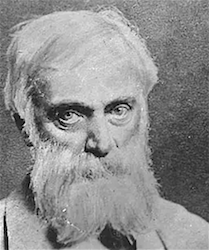
George Devey was born in Kentish Town, London, England on 23 February 1820. His uncle was the painter Augustus Egg (1816-1863), and it may have been from him that he acquired his early interest in art. From 1832 to 1835 he took lessons in drawing and watercolour painting with John Sell Cotman (1782-1842) at King's College School in London. Devey was steered away from pursuing a career as a painter by his father, and instead, in 1837, was articled to the architect Thomas Little (1802-1859) in Northumberland Street, London. After completing his articles he remained with Little who employed him as a draughtsman.
In 1846 Devey toured what are now Germany and Italy. Soon after his return he set up in practice at 16 Great Marlborough Street, London.
Many of Devey's commissions came from his connections in the Liberal Party and from bankers including Smiths, Glyns, Barings and the notably the Rothschilds. The Rothschild family was one of Devey's major patrons in the latter years of his career, providing him with a steady stream of commissions.
Devey was a follower of theism, a religious concept espoused by the Rev. Charles Voysey (1828-1912), and it was through him that Devey became acquainted with his son, the architect Charles Francis Annesley Voysey (1857-1921) who worked in his office for two years.
In 1880 Devey moved his office from Great Marlborough Street to 123 Bond Street, London. In 1856 he was elected a Fellow of the Royal Institute of British Architects (FRIBA). He died at his brother's house, Devonshire House, Pelham Crescent, Hastings Sussex on 4 November 1886.
Devey received his first architectural commissions in the late 1840s - alterations to Penshurst Place in Penshurst, Kent and its gardens, and the restoration of small houses in Penshurst and Fordcombe for Philip Sydney, 2nd Lord de l’Isle, and Henry, 1st Viscount Hardinge. Over the next two decades Devey worked on similar relatively small projects such as the parish school in Benenden, Kent (1861), and the Old Rectory in Wickwar, Gloucestershire (1864), however, in the late 1860s he began to receive commissions to design, enlarge or restore more substantial country houses and mansions. Among these were Akeley Wood near Buckingham, Buckinghamshire (1867-68); Calverley Grange, near Tunbridge Wells, Kent (1867–70); Brantingham Thorpe, near Brantingham in Yorkshire for the Sykes family (1868-74); Lilies, Weedson, Buckinghamsire for Henry Cazenove (1869-71); Coombe Warren near Kingston upon Thames, Surrey for the banker B. W. Currie (late 1860s); Ascott, near Wing, Buckinghamshire for Leopold de Rothschild (1870-84); Swaylands, near Penshurst, Kent for Edward Cropper and George James Drummond (1870-74, 1881-82); Send Holme in Send, Surrey for Captain and Mrs William Hargreaves (1871-72); Hall Place, Leigh, Kent (1871–74) for Samuel Morley; Goldings, near Hertford, for Robert Smith (1871-74); Denne Hill, Womenswold, Kent for Edward Dyson (1871-75); Walmer Castle in Walmer, Kent, for the second Earl Granville (1872–75); St. Alban's Court in Kent (1874-78); Ashfield at Handcross, Sussex (1875-78); eythrope , near Waddesdon, Buckinghamshire for Alice de Rothschild (1876-79); lakesware Manor, Wareside Hertfordshire (1876-79); Killarney House, Killarney, County Kerry, Ireland the Earl of Kenmare (1877-79); Melbury House in Melbury Sampford near Evershot, Dorset, for the fifth Earl of Ilchester (1884–86); Gaunts House in Dorset (1886); and Dunraven Castle, near Southerndown, Glamorganshire for the Earl of Dunraven (1886-88).
_____
See also:
British Listed Buildings - 138 listed buildings by George Devey [link below]
Historic England - 273 entries on George Devey [link below]
Allibone, Jill. George Devey architect, 1820-1886. Cambridge, England: Lutterworth Press, 1991
Armstrong, Barrie and Armstrong, Wendy. The Arts and Crafts movement in the North West of England: a handbook. Wetherby, England: Oblong Creative Ltd., 2006
Avery, Derek. Victorian and Edwardian Architecture. London: Chaucer Press, 2003
Binney, Marcus. 'Penshurst Place, Kent'. Country Life vol. 151, 4 May 1972 pp. 1090-1093 [Discusses the additions made by George Devey and J. B. Rebecca to Penshurst Place in the 1850s and 1860s]
Directory of British Architects 1834-1914. Compiled by Antonia Brodie, et al. Volume 1: A-K. London; New York: British Architectural Library, Royal Institute of British Architects/Continuum, 2001
Girouard, Mark. 'George Devey in Kent'. Country Life vol. 149 1 April 1971 pp. 744-747 [First part of a two-part article on the country houses in Kent designed by George Devey in the 1870s]
Girouard, Mark. 'George Devey in Kent'. Country Life vol. 149 8 April 1971 pp. 812-815 [Second part of a two-part article on the country houses in Kent designed by George Devey in the 1870s]
Girouard, Mark. The Victorian Country House. New Haven and London: Yale University Press, revised and enlarged edition, 1979
Godfrey, Walter H. The work of George Devey, Fellow of the Royal Institute of British Architects.(1820-1886). London: Privately published for Messrs. Wratten and Godfrey by B.T. Batsford, 1907
Godfrey, Walter Hindes. ‘George Devey , F.R.I.B.A., a biographical essay’. Royal Institute of British Architects Journal vol. 3 (new series), no. 12, 29 September 1906 pp. 501-525
Godfrey, Walter Hindes. ‘The work of George Devey’. Architectural Review vol. 21, January 1907 pp. 23–30 [First part of a three-part article]
Godfrey, Walter Hindes. ‘The work of George Devey’. Architectural Review vol. 21, February 1907 pp. 83–88 [Second part of a three-part article]
Godfrey, Walter Hindes. ‘The work of George Devey’. Architectural Review vol. 21, June 1907 pp. 293–306 [Third part of a three-part article]
‘Obituary’. The Builder vol. 51, 20 November 1886 p. 728
‘Obituary’. Royal Institute of British Architects Proceedings vol. 3, 1887 pp.46-47
Stamp, Gavin. The English House 1860-1914. Catalogue of an exhibition of photographs and drawings. London: International Architect and the Building Centre Trust, 1980 p. 8
Stone, Percy G. ‘The late George Devey’. Building News vol. 51, 12 November 1886 p. 721